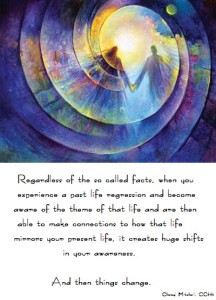Why Can’t You Stay On Track?
What beliefs are taking you off your path and how do you change them?
You want to make a change and it’s not working. You made the decision, bought the things you need to insure your success, picked a start date and began in grand fashion. Then in a couple of weeks, or a few days more likely, you were back into the old habit once again and the new habit is in the rear-view with plenty of reasons why you can’t do whatever it is you promised yourself you would do. Your motivation is lost and worse, you feel crummy about yourself because you just can’t stick with it.
After you get done beating yourself up, you may want to genuinely look into why, despite your best intentions, changing habitual behavior seems to be so darn hard some times. Have you ever considered why it is that one person can simply decide to change, perhaps to begin to meditate every day, and they easily, almost effortlessly fit in the time while the next person can’t find ten minutes to devote to it? What gives? Is it really just as simple as will power? One person has it and one doesn’t?
No. The answer is much deeper, more elusive and far more powerful. That something is belief. The belief or beliefs attached to a behavior are the critical elements to your success in changing your behavior. Regardless of what you think, what you feel determines your behavior. The strongest emotion always wins. ALWAYS.
To discover why you can’t change your behavior, you can dig up your subconscious beliefs and subconscious programming related to the subject. Find out what you truly believe, not just what you think you believe. The easiest way to do this is to play a little game with yourself to find out what you are getting out of not changing your behavior. Find the secondary gain; what it is you’re getting by maintaining the habit you think you want to change. But you have to allow the answers to surface from your deep inner mind, to bubble up from the depths of your subconscious, not skimmed off the top of your conscious mind.
If you want to meditate for fifteen minutes every morning, yet have not been able to find the time, to find out how you really feel about it, take a moment to think about the situation. Pretend you are experiencing it in that moment and get in touch with your feelings about it. Then ask yourself a question such as, “Thinking about giving myself this time every day makes me feel _________________ .” Let the emotion come up. Don’t force it. Do this repeatedly to really dig it out, maybe even fifteen or twenty times if you have to. The first several answers might be coming out of the conscious instead of subconscious mind. You may discover that wanting to take time for yourself makes you feel sad. Don’t worry if your answer doesn’t seem to make sense. It doesn’t have to.
Next, take each emotional response and find the belief that resonates with it. For example, “Thinking about giving myself this time every day makes me feel sad, and that makes me feel like I am _________________ .” The response may come up that you feel like you’re being selfish. Now you are beginning to get a glimpse of what is keeping you from meditating. If part of you feels you are being selfish, and you believe that selfish people are bad, then you’ll never let yourself meditate because you want to be a good person.
Now look into your past, your early childhood most likely, where those beliefs were formed. Did your mom have a habit of taking a few minutes for herself and your dad always scolded her and told her she was being selfish? Or visa versa?
It’s possible you can clear the belief yourself by choosing to simply “let it go” every time it comes up or you may need help from a hypnotherapist or other practitioner to help you release or transform it. Remember, too, you don’t always have to know exactly where a belief came from to clear it. Once it is uncovered and brought to the conscious mind you can begin to alter it. And setting the intention to do so is a great first step.
Are You Your Own Worst Enemy?
Have you ever found yourself fighting an internal battle about an upcoming important decision you need to make, or second guessing yourself and even throwing emotional grenades at yourself over a decision already made? Are you berating yourself because you made the “wrong” decision and keep kicking yourself while you’re down, so to speak? If so, have you noticed how that also negatively impacts your ability to make a confident decision the next time you need to? You may keep referring back to your screw up and keep yourself stuck with the continual reminder that you can’t do anything right.
This internal conflict, or emotional warfare we wage on ourselves, is something that everyone has or will experience at some point. The ammunition we use to inflict our wounds in this bitter struggle can range from internal abusive dialogue to undesirable behavior such as overspending or poor work performance to outright physically harming ourselves through sabotaging behavior like excessive drinking, taking drugs, or overeating. Sometimes we can even bring on a good cold or flu to punish ourselves, or even in extreme cases, manifest an illness. The most common result I have witnessed is an experience of immobility; a lack of moving forward or making a decision and sticking with it.
Yet, this common experience needn’t be an everyday occurrence. It can, at the very least, be managed. You can even learn how to avoid this emotional war zone altogether and experience an expanded awareness of peace of mind and a feeling of improved confidence in your decision making.
First off, remember that this internal conflict is part of the way our subconscious mind works. The subconscious holds beliefs that are diametrically opposed to one another, and whenever either belief is activated, it seems true while being experienced. This is why we experience the warring parts of ourselves where one part wants one thing and another part wants the opposite thing.
Understand that each part has a job to do and is doing the best it can to help you in some way. These parts of our personality can be very strong and effective in molding our behavior. They are often times created during our young childhood in an effort to keep us safe in some way, whether the threat was real or imagined, and that is why at times it can be difficult to change the long held belief. It has served us for a long time and it can be a little frightening to let it go.
So the idea is not to try and cut the part out of you, but rather to first be aware of it and then to see if you can figure out what purpose it may serve. This process is best served with awareness and non-judgement, so start by accepting that you are in conflict with yourself and be okay with that. You have conflicting wants or desires (or parts) and you are allowed to have those conflicts. It doesn’t make you bad or wrong. The thoughts are stemming from your emotions and there, too, you are allowed to feel how you feel. Your emotions exist because of the beliefs that you (a part of you) hold about each side of the argument, and again, it is okay for those beliefs to be in conflict with each other. You can work through all this and come to a place of peace.
Awareness is a first step and then willingness to allow yourself to investigate both sides and thoroughly uncover the motivations and beliefs from all angles. Think of it as entering into peace talks. Both sides think they are right and want to be fully listened to and understood. That alone can bring great insights to help negotiate the peace treaty with yourself and perpetuate a dialogue to begin to bring about a better understanding from each side about each side so that peace can reign once again.
http://consciousshiftcommunity.com/are-you-your-own-worst-enemy-the-war-on-you/
Fitness is More Than Physical
Are you a balanced and healthy version of fitness?
Many people are focused on physical fitness to the point of causing an imbalance in their emotional fitness. Perhaps you know of someone who is killing themselves at the gym every day, obsessively working out and depriving themselves of desirable foods in order to transform their body into one that is considered socially accepted. They may reject their natural form and consistently degrade themselves with comments like “I hate my thighs” or “My butt makes me look a bus!”
If so, have you wondered about that person’s mental state or emotional fitness? I’m all for being active and physically fit, eating well and exercising on a regular basis, yet if you are not fit emotionally, then what price glory? You may have what is considered a beautiful physique, but if you are obsessing over every calorie, and judging yourself as unacceptable in any way because of some perceived physical flaw, whether it be that your thighs are too fat or your arms are too skinny, then how can you truly be fit? Doesn’t true fitness also include a state of emotional wellness?
But how do you determine if you are emotionally fit? It’s not something that can be measured by the number of push-ups you can do, how much you weigh, your height or body type, your blood test results, or even by how others perceive you.
One easy way to begin to attain emotional fitness is to ask yourself how happy you are. Are you happy now? Or will you be happy when? Or happy if? Fill in the blank on those last two questions. Are you waiting for an event to occur, some kind of accomplishment, or another person to act in a certain way before you can be happy? When you finally drop those last ten pounds, or when your boss publicly acknowledges all your hard work?
And take a moment and consider how you respond to people and events? Do you find yourself taking responsibility for the emotional states of others, then becoming anxious or upset yourself because of the way they are feeling? Do you neglect your own interests because someone else may get mad at you or rebuke you for them? Do you let other people determine your value for you? Feeling that only if another person approves of you can you feel good enough, and if your appearance, actions or opinions are disapproved of, you then feel worthless or not good enough?
So where do you begin if you decide you are not as happy, or as emotionally fit as you would like to be? Do you have an idea of what being emotionally fit would be for yourself? That may be a good place to start. Simply observe other people who appear to be more emotionally fit in the way in which you want to be. Do you want to be more self-accepting? Then find someone who seems to you to be self-accepting. It could be a friend or family member, or a co-worker, or even a celebrity or someone in the media spotlight.
Once you have someone in mind then you have something to evaluate your progress against, a yard-stick to measure with, so to speak. Remember the idea is to evaluate, not judge. Do you remember when the WWJD bracelets that were all the rage? The brightly colored bands that prompted the wearer, when a decision needed to be made, to ponder “What would Jesus do?” That’s an effective mindfulness tool. Except perhaps, you could ask yourself what the person whose traits you wish to emulate would do in a given situation. You may not know for certain how that person would react, yet given what you do know about them, you can likely speculate their response. Then imagine yourself responding in that same way.
Although a tiny step, do not discount its effectiveness. The smallest degree of change can vastly alter an outcome over time. Adopting this simple mental habit is far easier than going to the gym every day or quitting carbs! And its result far more life changing as it moves you into a new way of thinking about everything. The trick to the application, however, is to ask the question and apply the result without personal admonishment or judgment. Do not consider yourself wrong if you have not up to this point acted in that way; instead, merely respond as best you can in the newly uncovered manner and notice the shift you experience in yourself as you begin to create your own emotional fitness.
As you become more practiced at being aware of your responses, and gently altering them as well as your actions, it gets easier and you may soon find yourself steadily shifting into an expanded experience of emotional fitness.
As seen in Conscious Shift Magazine
Aligned and Naturally Centered
As we roll into a new year many people spend time reviewing the past year and looking at ways to improve themselves and their lives. New Year’s resolutions are proclaimed and vows made to do things differently next year. January first starts off with drastic changes and steely determination only to have that determination dissolved in a few days and old habits once again ruling the day. Working to make drastic changes usually results in failure. Balance is an important component to lasting change.
How would your life be different if you experience a true sense of balance? What if you could live more harmoniously and with greater peace of mind without evoking sheer will power? What if you could begin to be aligned lovingly and naturally centered everywhere? To experience more balance?
It’s an appealing idea, isn’t it? To be aligned lovingly and naturally centered everywhere? But how do you do that?
I believe the first step is willingness. Nothing begins without first having the willingness to be, do or have the thing, experience, or way of being you desire. Then once you have established that you are willing to be aligned lovingly and naturally centered everywhere, you next have to be willing to do what it takes for you to experience that state in your unique way. Which means you need to be willing to be different than you are now, which means you need to be willing to let certain things go and be willing to allow others things into your experience.
It sounds easy, right? The thing is though, as you may have experienced if you have ever truly committed to consciously shifting into a new experience, the doing and the being can be very different things. But how hard could it be? It sounds so soft and pleasant to be aligned lovingly and naturally centered everywhere. Sure. And it is. Once you’ve done it. But in the process you may find that you meet the unwanted head on in your quest.
Why? Perhaps because to be aligned lovingly and naturally centered everywhere, you have to get out of your head and into your heart. You have to let love lead. You have to let go of attachments, to having things be the way you want them to be. You have to let others be in whatever space they find themselves in and not take anything they do or say personally. You have to give up being offended or needing to be right. You need to stop judging and start accepting. Letting things be. And it’s not about liking the things you don’t like. It’s about letting those things be what they are and not making someone else wrong for liking them, either. You can’t show everyone that you are the smartest person in the room and be aligned lovingly and naturally centered everywhere, because you can’t be leading with your ego and be in balance spiritually.
So take it slow, play with it a few minutes at a time. Perhaps when you find yourself in the middle of yet another boring staff meeting and are beginning to feel aggravated at your coworker because she always has to be the first one to comment on everything the boss says, you instead turn your awareness inward an ask yourself how you could experience this person differently? So now instead of experiencing the self gratifying judgment of making your coworker wrong for her behavior, you consider her and why she might behave that way. What if you acknowledged to yourself that you really do not know why she behaves that way, and simply accept that her behavior must serve her in some way. What if you decided to feel lovingly toward this woman instead of judgement of her?
Do you think looking at someone through compassion could help you shift how you feel and help you be more balanced? Or at least closer to it in any given moment? And then, like anything else you practice, you’ll get better at it the more you do it. Soon you could experience a greater sense of balance as you discover you truly can be aligned lovingly and naturally centered everywhere.
As seen in Conscious Shift Community 12-29-15
Self Hypnosis

Hypnosis is a powerful method to make permanent changes in one’s life. yet a majority of people do not know that they can easily use self-hypnosis. Maybe because they don;t know much about it. So let’s take a minute to demystify hypnosis by first taking a look at what hypnosis is. For the sake of brevity, I’ll defer to FIH Fundamentals of Hypnotism manual’s general working definition: “A natural, yet altered state of mind where communication and responsiveness with the subconscious mind is present.”
Now let’s look at that further. It is natural, so it requires nothing artificial to attain it and therefore, anyone can experience it. It’s an altered state, no it’s not regular or typical which implies something needs to be done to attain it. So far so good.
“Where communication and responsiveness with the subconscious mind is present.” This is where we start to run off the rails a bit, yet, stick with me and you’ll see it is not such a mystery. Everyone has a subconscious mind and communicates with it and it communicates with us. It determines your behavior since the “knowns” in the subconscious mind create our habits, responses and behaviors. The difference is while in hypnosis the subconscious is responsive to new ideas, which become new “knowns” and then change the existing programming.
To help you get started, I’ll give you an example. Let’s say you want to feel calmer in social situations. Start by finding a place where you can relax for 15 to 20 minutes undisturbed. Sit or recline, be comfortable, yet not so comfortable that you fall asleep. Find a spot high on the wall to stare at and focus all your attention there and as you do take in a deep breathe. As you exhale tell yourself to relax. Keep staring at the spot and do that twice more, then breath normally and tell yourself that you are going to count backward from 5 down to 1 and when you get to 1 then you’ll close your eyes and start to enter into a hypnotic state. Now count backward slowly and when you say 2, take in a deep breath and when you say 1, exhale it and allow your eyes to close. Remind yourself that you are now entering into hypnosis. Next bring your attention on your closed eyelids and repeat several suggestions to yourself that they are so heavy they won’t work. Then just pretend to open them and find that they don’t open. (Remember, you are pretending to try to open them here.)
Now tell yourself that in a minute you’ll open and close your eyes and that’s your signal to deepen your state. Now open your eyes briefly and as you close them remind yourself that you are deepening your state. Do that twice more, then tell yourself that in a minute your body will start relaxing one part at a time and give yourself suggestions to relax and go deeper as you talk yourself through relaxing your body from your toes to your head.
Once you are completely relaxed repeat suggestions to yourself that are simple and easy to understand with an increasing element of improvement and ones that have a strong emotion desire for you, such as ” Now, more and more, I find myself feeling more calm and more relaxed in social situations. Say the suggestion three times, then say your next suggestions three times. Another one might be “Everyday in every way I am now more relaxed when interacting with others.” After repeating your suggestions, take a few minutes to imagine yourself in the new way, so “see” yourself being more calm and relaxed in social situations and allow yourself to feel the improved emotion of the new way of being. After finishing the visualization, tell yourself that you’ll count from 1 to 5 and when you get to 5 you’ll open your eyes and be back to your regular waking state. Then count yourself up and “de-hypnotize” yourself.
Repeating the suggestions, seeing yourself acting differently and feeling the improved emotion impacts the subconscious mind and creates change. In this way self hypnosis is something that can be easily learned and utilized daily as a pleasant way to improve your life.
Living With an Open Heart
I’ve been thinking alot lately about what it means to live with an open heart and I’ve decided that like most things. what it means to me is not necessarily what it means to someone else.
So for me, living with an open heart means living my life without judgement, at least as much as I consciously can live without judgement. I am after all, still human, and subject to all the ego-based things that go along with the human experience, so Obviously, some days I do better with this than other days. And honestly, sometimes it has to be taken topic by topic. But when I choose to keep my heart open, then I get the opportunity to evaluate those judgements and see how they may be holding me back or causing me limitations, and then I can transform them and improve my experience.
Living with an open heart allows me to feel how I feel and be in touch with those feelings. I don’t have to do anything with the emotions that arise, I just let them come up and move through me. There is always time to look at what comes up later, yet in the moment, I do my best to let the energy of the emotion to just move through me.
In our society where we are taught to “do” instead of “be,” this takes some practice. I have shared an Opening the Heart Meditation with many of my clients to help them get in touch with their emotions as we are use hypnotherapy to help them resolve issues in their lives. To help them undo their conditioning. It’s easy to want to lash out at someone if the emotion that comes up is hurt or anger, and conversely, many of us have been taught to deny our feelings so we suppress them instead of feeling them. When you live with an open heart, though, you don’t lash out or suppress. You acknowledge and feel.
When you acknowledge and feel your emotion then the energy of the emotion (energy in motion) moves and transforms instead of getting stuck and trapped. Your health improves. Your outlooks improves. Your life improves in every way.
The Power of Intention
An important component to any hypnosis session, whether it is for a regression or for programming, is to first establish the intention for the session.
Setting an intention puts the subconscious on notice that it’s cooperation is needed. After all, hypnosis is a phenomenon of cooperation, both with the client, and the client’s subconscious. The intention is really the first step in the process of change.
Your intention is paramount in the hypnotherapy process, both at the beginning of a session and then to have the intention to complete the process, whether clearing your issue takes several sessions, or perhaps being willing to look at some uncomfortable things from your past so they can be transformed, or in committing to listening to a daily programming recording.
Change is a process, one that hypnotherapy can help with quite quickly, yet it all starts with your intention first.
To learn more of how intention works with hypnotherapy, please join the Consious Community Discussion on Monday everning, 7:00 PM EST on 2/2/15, at www.tfioh.com
Past Life Regression Hypnotherapy Brings Self Awareness
Past Life Regression is a great way to gain perspective on special talents, or interests and can to help to transform deep personal issues that may be impacting your life in unproductive ways. Patterns and themes from the past life are uncovered and many times, the idea of karma needing to be worked out is also uncovered.
Many people believe karma is Universal balancing, and that the purpose of life is to work karma out, or repay it somehow. If that is the case then perhaps you may believe that the past life is an factual previous life experience, and you can learn about the clearing or balancing of karma from that life-time. This could be a very important piece of information for this life as you may find similar themes being played out.
Regardless of whether or not you believe a past-life experience to be true, when you experience a past life regression and become aware of the theme of that life and are then able to make connections to how that life mirrors your present life, it creates huge shifts in your awareness. And then things change.
Being Out of Your Mind is Absurd
Are you out of your mind?
Has anyone ever asked you that? Did you really think about the question before you answered? The question implies several things: that being “out of your mind” is a bad thing as is you have “lost it” or are crazy, that you are supposed to be “in your mind,” and most interestingly, that you can actually leave your mind.
The concept is absurd. How can someone be in their mind or out of their mind when the mind is not an actual place? You can be in your body or out of your body, but you can’t be out of your mind. Even when you are out of your body, your mind is still present.
How can that be? Your mind, whatever your mind rally is, is connected to the part of you that can actually leave your body as happens during an out-of-body-experience. If you have ever had an out-of-body-experience, then you know that your mind was present because you remember it. People who have had near-death-experiences, the most profound out-of-body-experience, are able to report on the event once they have returned to their bodies.
This is an intriguing concept, one that you may have been curious about, yet not so intriguing that you are willing to play chicken with death in order to learn more about it. Rest assured that you do not need to come close to death to have the experience of being out of your body. There are hypnosis techniques that can help you achieve the state needed to leave your body and to know first-hand what it is like to be outside or yourself and still fully aware. And it doesn’t require years of hypnosis or hypnotherapy training to achieve, either.
It starts with achieving a state of relaxation and then deepening that state further, all while maintain your awareness. It is a state where your body is sleeping, yet your mind is aware and aware. In this state you become aware of your spirit, and that your spirit is separate from your physical body. You can learn to move your spirit out of your body and experience existence on a far grander scale.
If you would like to learn more about this topic, log onto www.tfioh.com and join the Monday Night class on 10/6/2014 at 7:00 PM (EST). Or you can review it as well as past classes from the library at http://www.tfioh.com/Self-Improvement-Class-Downloads.html
It can take practice and discipline to learn to achieve and out-of-body-experience, yet the time dedicated to the practice is exceedingly rewarding once you have mastered the ability to leave your body and begin to remember who you truly are and reconnect with the Universe as an active participant. And remember that your mind goes with you so no matter how far into the reaches of the cosmos you travel while out of your body, you will never be out of your mind.











